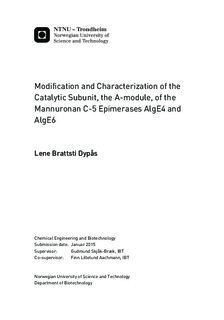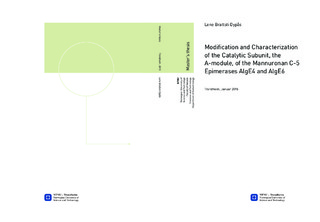| dc.description.abstract | Alginate is a family of polysaccharides composed of (1 to 4)-linked beta-D-mannuronic acid (M) and alpha-L-guluronic acid (G), with a wide variety of applications and even greater prospects for the future. Alginate is first synthesized as poly-beta-D-mannuronic acid and the G-residues are introduced by enzymatic C-5 epimerization of individual M-residues, with different enzymes introducing different degrees of epimerization and patterns. The physical properties of alginates are highly dependent on their chemical composition, and their great degree of sequential and compositional variation creates the need for structural control. By expressing mannuronan C-5 epimerases in their native, or even hybrid form, in alginate-producing bacteria, it could be possible to produce alginates with carefully designed properties and a high level of compositional homogeneity. This is especially promising for the strict demands of biomedical applications.
Great efforts have been made to obtain detailed characterization of the C-5 epimerases and their interactions with alginates, yet much is still unclear. In particular, a family of seven extracellular epimerases of Azotobacter Vinelandii, AlgE1-7, has been extensively studied. They all consist of two structural domains; the A-module, which has been found to hold the catalytic activity, and the R-module, whose role is not yet defined, but has been suggested as regulatory.
This study, in two parts, aims at further clarifying the role of the R-module, specifically in AlgE4, and to learn more about the structure function relationship in the A-module of AlgE6.
The first part is a comparative study of the A-module in AlgE4 and the full length epimerase. The result of this work supported previous findings of the R-module having a role in lowering the concentration of calcium ions needed for full activity in AlgE4. They also suggested that the R-module facilitates a stable degree of epimerization within a wider calcium concentration range, but that it was not needed to achieve full degree of epimerization. No evidence was found to suggest that the R-module gives rise to product specificity, but it did increase processivity, possibly by contributing to stronger association with the alginate polymer. Results concerning temperature dependence were inconclusive, and further work is needed.
In the second part, structures in the C-terminal region of the A-module were studied by creating three AlgE6A clones with varying degree of truncation at the C-terminal end. It was hypothesized that removal of the first 49 residues (AlgE6A_336) would give a functional epimerase, removal of 90 residues (AlgE6A_295) would significantly reduce epimerase activity, and removal of 114 residues (AlgE6A_272) would give a non-functional epimerase. Only AlgE6A_336 resulted in introduction of G-residues, and the G-content in its product was minimal. Structures at the C-terminal end were therefore revealed to be more essential for activity than first thought. Results suggested that the loop extending from the beta-helix could be especially important, as the side of this loop became exposed in AlgE6A_336, where almost all activity was lost, and then completely removed in AlgE6A_295 along with complete loss of function. It was also noted that removal of the R-module is a less invasive modification as it cuts the protein at a transition between structurally separate domains, while the truncation at the C-terminal cuts within one such defined domain. Structural analysis of the AlgE6A clones would be the next step in this work, to identify whether improper folding could be the reason behind this loss of function. | |

